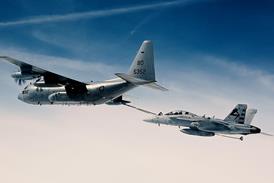Guy Norris/LOS ANGELES
Boeing has clocked up three landmarks in its Next Generation 737 programme with its launch of a stretched 737 (the -900), US Federal Aviation Administration certification for the -700 and completion of assembly of the first -600.
The -900 was launched with a $1 billion-plus order from Alaska Airlines for ten firm and ten options, and pitches the 737 into head-to-head competition with Airbus Industrie's 185-seat A321 for the first time.
The stretch enables seating for 15 more passengers, allowing up to 177 to be carried in a two-class layout, although, requirements for emergency exits mean that the aircraft's maximum seating can not go beyond the 189 seats already reached by the 737-800.
Boeing's plans for the -900X growth derivative were first revealed to suppliers in April (Flight International, 7-13 May). Alaska has been a launch prospect since the variant first emerged, and in 1996 it was persuaded by Boeing to abandon plans to buy MD-90s in favour of the 737 family.
Boeing's decision on 3 November to terminate the MD-90 was therefore strongly linked to the launch of the -900.
The -900 fuselage will be produced by inserting a 1.57m plug forward of the wing and a 1.06m plug aft.
Overall length will increase to 42.1m, compared to 39.5m for the 162-seat -800.
The stretch makes the -900 almost 11m longer than the smallest Next Generation model - the 108-seat -600 (see diagram).
Despite the length increase, maximum take-off weight is being kept at the -800's limit of 79,000kg, with a resulting range decrease of almost 370km (200nm) to just over 5,000km.
The aircraft otherwise remains virtually identical to the rest of the Next Generation family and will use the same systems, CFM International CFM56-7 engines (rated at up to 120kN thrust) and tail-skid of the -800. Deliveries to Alaska are expected to begin in early 2001.
Meanwhile, Southwest Airlines, launch customer for the Next Generation series and the -700 in particular, is now expected to take delivery of its first aircraft in the last week of November. Although it is more than a month later than had originally been scheduled, the delivery follows FAA certification which was granted formally on 7 November.
Certification was delayed from early October by last-minute structural changes to the horizontal stabiliser. European Joint Aviation Authorities certification is still awaited, pending clearance of a revised emergency-exit design to meet more-stringent evacuation requirements.
The JAA understands that Boeing has completed the exit testing, and JAA officials are now working through the results. "This is one of several outstanding technical issues," says JAA secretary-general Klaus Koplin, "but it is very likely that approval will be granted in early December."
Boeing has also completed assembly of the first 737-600 and is scheduled to roll out the aircraft in early December. Three -600s will be involved in the flight-test programme, which is expected to be completed around June 1998, with first deliveries to launch customer SAS beginning soon afterwards.
Source: Flight International























